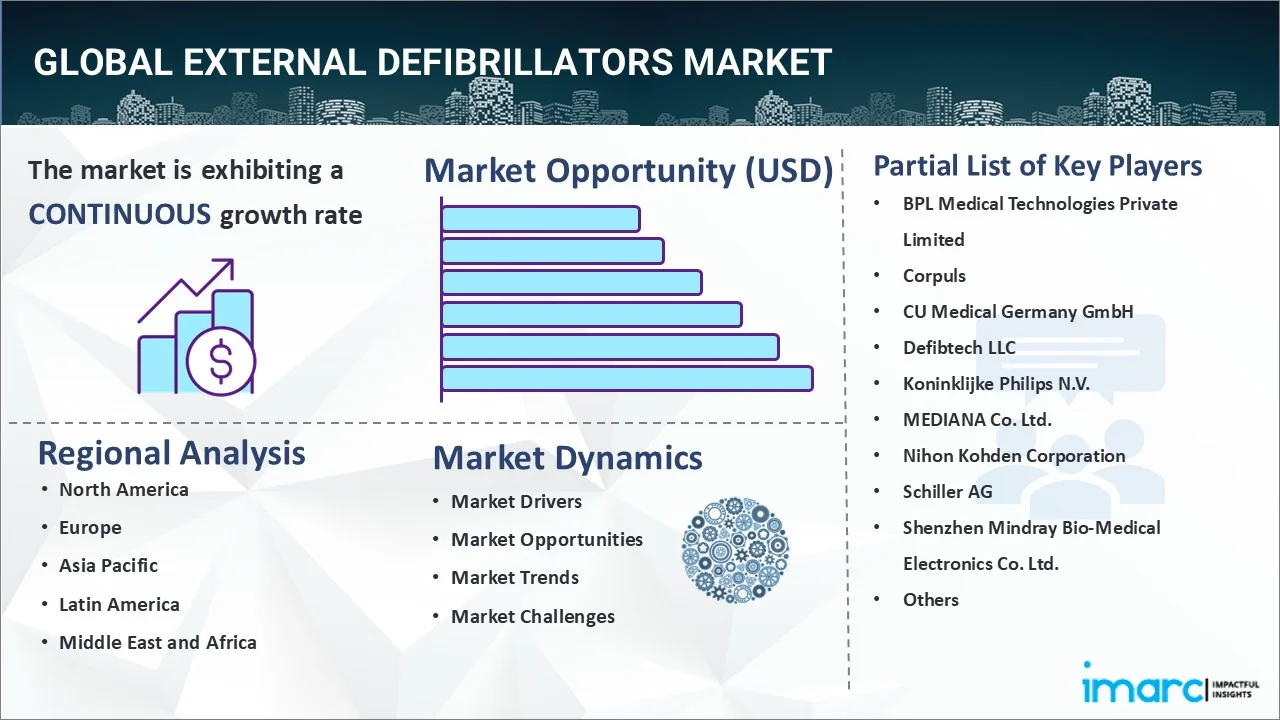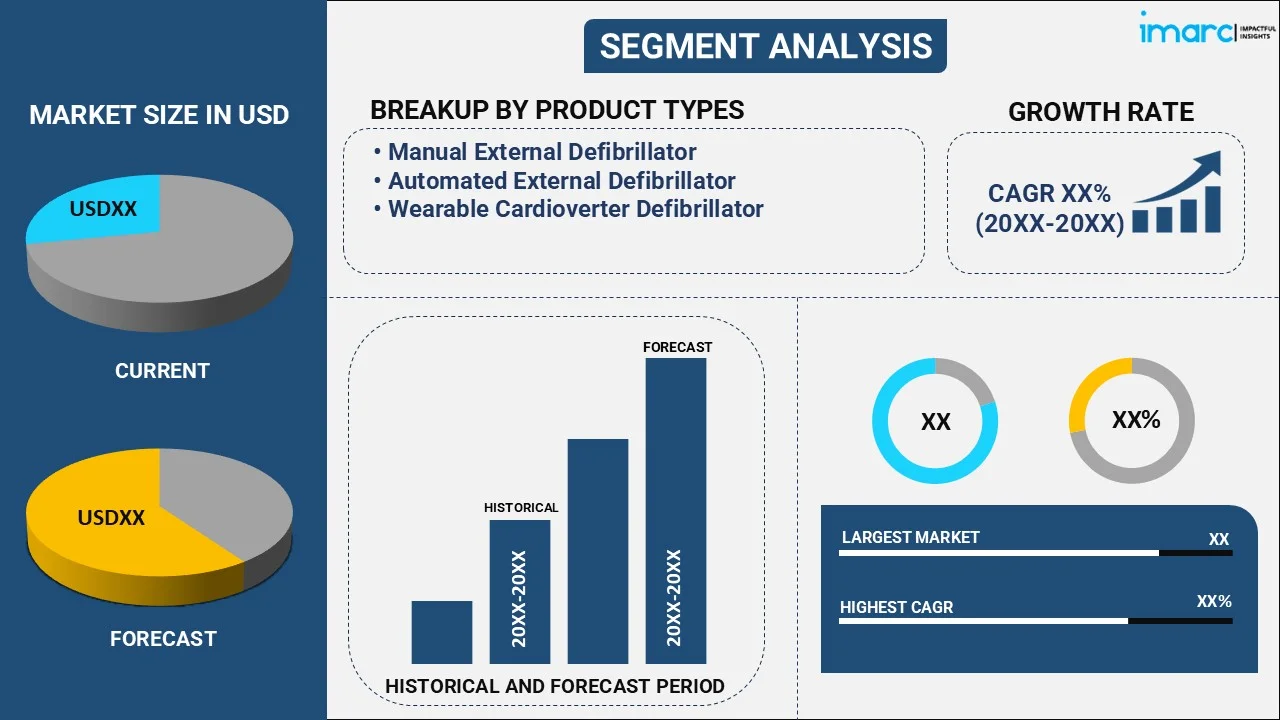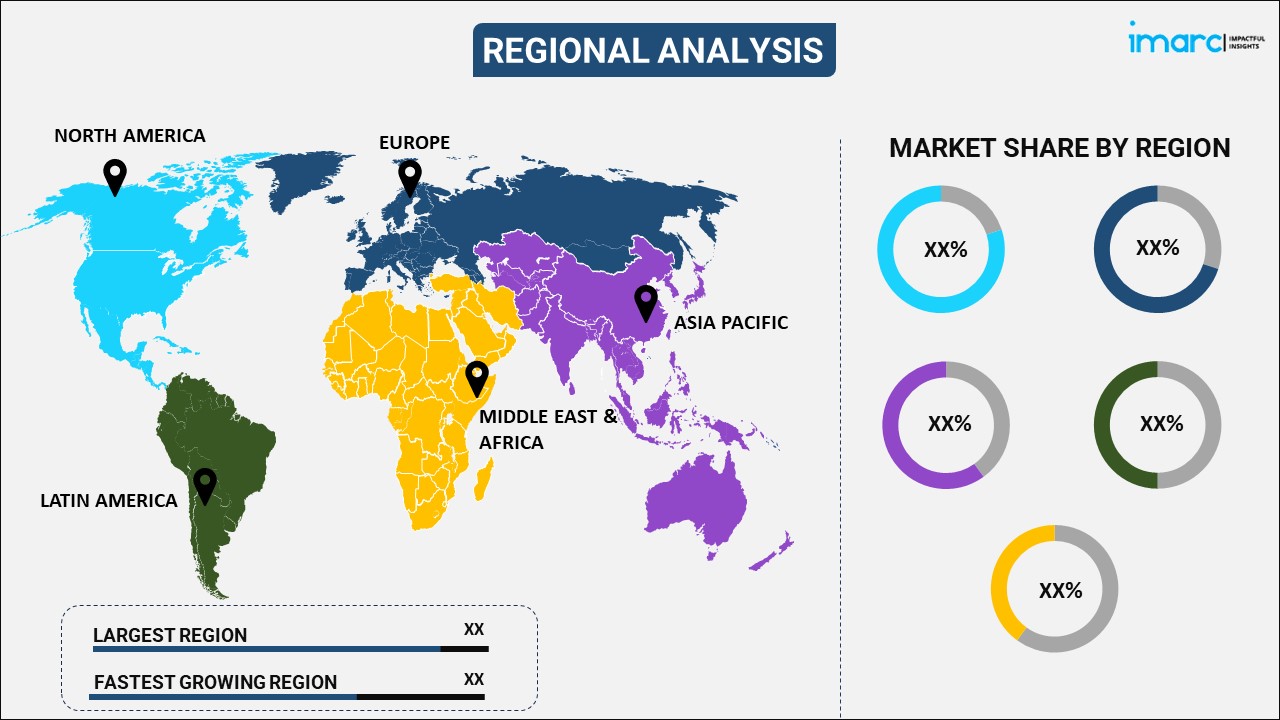
External Defibrillators Market Report by Product Type (Manual External Defibrillator, Automated External Defibrillator, Wearable Cardioverter Defibrillator), End User (Hospitals, Pre-Hospitals, Public Access Market, Alternate Care Market, Home Healthcare), and Region 2025-2033
Global External Defibrillators Market:
The global external defibrillators market size reached USD 3.6 Billion in 2024. Looking forward, IMARC Group expects the market to reach USD 6.7 Billion by 2033, exhibiting a growth rate (CAGR) of 6.87% during 2025-2033. The rising incidence of cardiovascular diseases, expanding aging population, increasing government initiatives, and ongoing technological advancements are primarily driving the market's growth.
|
Report Attribute
|
Key Statistics
|
|---|---|
|
Base Year
|
2024
|
|
Forecast Years
|
2025-2033
|
|
Historical Years
|
2019-2024
|
|
Market Size in 2024
|
USD 3.6 Billion |
|
Market Forecast in 2033
|
USD 6.7 Billion |
| Market Growth Rate 2025-2033 | 6.87% |
External Defibrillators Market Analysis:
- Major Market Drivers: The widespread prevalence of out-of-hospital cardiac arrest (OHCA) determined by the loss of mechanical cardiac function and the absence of systemic circulation, which is a leading cause of mortality among adults, represents one of the key factors impelling the external defibrillators market growth.
- Key Market Trends: There is a significant rise in the number of people with hypertension, diabetes, and obesity on account of unhealthy diets, physical inactivity, and the growing consumption of tobacco and alcohol. These intermediate risk factors can be evaluated in primary care facilities and indicate an increased risk of a heart attack, stroke, and other complications, further driving the external defibrillators market size. Apart from this, modern external defibrillators are inexpensive, easy to operate, and safe for users. This, coupled with rising technological advancements, is positively influencing the external defibrillators market growth.
- Competitive Landscape: Some of the prominent external defibrillators market companies include BPL Medical Technologies Private Limited, corpuls, CU Medical Germany GmbH, Defibtech LLC, Koninklijke Philips N.V., MEDIANA Co. Ltd., Nihon Kohden Corporation, Schiller AG, Shenzhen Mindray Bio-Medical Electronics Co. Ltd., Stryker Corporation, and ZOLL Medical Corporation (Asahi Kasei Corporation), among many others.
- Geographical Trends: According to the external defibrillators market dynamics, North America holds a prominent share in the global external defibrillators market. The high adoption rate of advanced healthcare technologies, a well-established healthcare infrastructure, and favorable reimbursement policies are major contributors to the market’s growth in this region. Moreover, Europe is another major market for external defibrillators, led by countries like Germany, the UK, France, and Italy. The region benefits from a growing elderly population, rising incidences of cardiac diseases, and a focus on improving emergency medical services.
- Challenges and Opportunities: The high cost of devices and lack of public awareness are hampering the market's growth. However, integrating defibrillator technology with mobile health (mHealth) and wearable devices can offer significant opportunities for preventive care and monitoring. Wearable defibrillators, for instance, provide continuous monitoring and deliver therapy to patients at risk of cardiac arrest.

External Defibrillators Market Trends:
Aging Population
The world’s population is aging, particularly in developed regions. For instance, according to the World Health Organization, by 2030, one in every six persons in the world will be 60 or older. At this time, the proportion of the population aged 60 and up will rise from 1 billion in 2020 to 1.4 billion. By 2050, the global population of persons aged 60 and up will double (2.1 billion). As the aging population grows, healthcare systems and facilities are under pressure to provide solutions that cater to cardiac-related emergencies, fueling the demand for both public and home-use defibrillators. These factors further positively influence the external defibrillators market share.
Rising Prevalence of Cardiovascular Diseases
The increasing prevalence of cardiovascular diseases, including heart attacks, strokes, and sudden cardiac arrests (SCA), is one of the primary factors driving demand for external defibrillators. Globally, cardiovascular disease is the leading cause of death, accounting for a significant portion of healthcare needs. For instance, according to the World Health Organization, in 2019, an estimated 17.9 million people died from cardiovascular disease, accounting for 32% of all global deaths. 85% of these deaths were caused by heart attacks or strokes. The rising number of patients suffering from CVDs creates a greater need for life-saving technologies such as automated external defibrillators (AEDs), particularly in emergency situations outside of hospitals. These factors are expected to propel the external defibrillators market share in the coming years.
Increasing Awareness Campaign
Awareness about sudden cardiac arrest and the importance of early defibrillation is rising due to global efforts by healthcare organizations, governments, and non-profit organizations. Training programs for laypersons on how to use AEDs and respond to cardiac emergencies have increased over the years. For instance, in April 2024, Essex-Windsor EMS invited area company owners to become Cardiac Champions by installing Automatic External Defibrillators and teaching their employees how to it and also asked Windsor and Essex County residents to help map the public locations of these life-saving devices, thereby boosting the external defibrillators market share.
Global External Defibrillators Industry Segmentation:
IMARC Group provides an analysis of the key trends in each segment of the global external defibrillators market report, along with forecasts at the global, regional and country levels from 2025-2033. Our report has categorized the market based on product type and end user.
Breakup by Product Type:

- Manual External Defibrillator
- Automated External Defibrillator
- Semi-Automated External Defibrillator
- Fully Automated Defibrillator
- Wearable Cardioverter Defibrillator
The report has provided a detailed breakup and analysis of the external defibrillators market based on the product type. This includes manual external defibrillator, automated external defibrillator (semi-automated external defibrillator, and fully automated defibrillator), and wearable cardioverter defibrillator.
According to the external defibrillators market outlook, manual external defibrillators are used primarily by healthcare professionals in hospitals and ambulances. They require medical training to interpret cardiac rhythms and administer the appropriate shock levels. Moreover, AEDs are designed to be easy to use, even by laypersons, in out-of-hospital cardiac emergencies. They automatically assess the heart’s rhythm and, if necessary, deliver a shock to restore normal rhythm. Furthermore, WCDs are designed to continuously monitor the heart and provide defibrillation if necessary. They are often used as a temporary solution for high-risk patients who are not candidates for implantable cardioverter defibrillators (ICDs).
Breakup by End User:
- Hospitals
- Pre-Hospitals
- Public Access Market
- Alternate Care Market
- Home Healthcare
The report has provided a detailed breakup and analysis of the external defibrillators market based on the end user. This includes hospitals, pre-hospitals, public access market, alternate care market, and home healthcare.
According to the external defibrillators market overview, hospitals frequently treat patients suffering from heart attacks, cardiac arrhythmias, and sudden cardiac arrest (SCA). The high volume of cardiac emergencies necessitates the constant availability of reliable defibrillation equipment. Moreover, the growing occurrence of out-of-hospital cardiac arrests (OHCAs) has increased the need for defibrillators in ambulances and with first responders. Quick access to defibrillation significantly improves survival rates in such cases. Furthermore, governments and organizations are implementing Public Access Defibrillation (PAD) programs, which mandate the installation of AEDs in public spaces. These programs aim to increase the availability of defibrillators in areas with high foot traffic.
Breakup by Region:

- North America
- United States
- Canada
- Asia-Pacific
- China
- Japan
- India
- South Korea
- Australia
- Indonesia
- Others
- Europe
- Germany
- France
- United Kingdom
- Italy
- Spain
- Russia
- Others
- Latin America
- Brazil
- Mexico
- Others
- Middle East and Africa
The report has also provided a comprehensive analysis of all the major regional markets, which include North America (the United States and Canada); Europe (Germany, France, the United Kingdom, Italy, Spain, Russia, and others); Asia Pacific (China, Japan, India, South Korea, Australia, Indonesia, and others); Latin America (Brazil, Mexico, and others); and the Middle East and Africa.
According to the external defibrillators market statistics, North America, particularly the United States, has one of the highest incidences of cardiovascular diseases and sudden cardiac arrests (SCA), fueling demand for defibrillators. Moreover, Europe has one of the oldest populations globally, which correlates with an increased incidence of cardiac diseases and higher demand for defibrillators in hospitals and alternate care settings. Countries like the UK, France, Germany, and the Nordic nations have launched PAD programs to promote the widespread use of AEDs in public spaces, especially in high-footfall areas such as train stations, airports, and shopping malls. Furthermore,
Competitive Landscape:
The market research report has provided a comprehensive analysis of the competitive landscape. Detailed profiles of all major market companies have also been provided. Some of the key players in the market include:
- BPL Medical Technologies Private Limited
- Corpuls
- CU Medical Germany GmbH
- Defibtech LLC
- Koninklijke Philips N.V.
- MEDIANA Co. Ltd.
- Nihon Kohden Corporation
- Schiller AG
- Shenzhen Mindray Bio-Medical Electronics Co. Ltd.
- Stryker Corporation
- ZOLL Medical Corporation (Asahi Kasei Corporation)
(Please note that this is only a partial list of the key players, and the complete list is provided in the report.)
External Defibrillators Market Recent Developments:
- April 2024: WEL Medical introduced the DefibSafe 3 (DS3), the next generation of Automated External Defibrillator (AED) storage with an IP66 weather protection grade.
- April 2024: Avive Solutions, a portable defibrillator firm, raised $56.5 million in growth equity funding to expand its team and commercial development.
- April 2024: The D.C. government developed a program to help pay for automated external defibrillators in places such as apartment complexes and houses of worship, particularly in African American communities.
External Defibrillators Market Report Scope:
| Report Features | Details |
|---|---|
| Base Year of the Analysis | 2024 |
| Historical Period | 2019-2024 |
| Forecast Period | 2025-2033 |
| Units | Billion USD |
| Scope of the Report | Exploration of Historical Trends and Market Outlook, Industry Catalysts and Challenges, Segment-Wise Historical and Future Market Assessment:
|
| Product Types Covered |
|
| End Users Covered | Hospitals, Pre-Hospitals, Public Access Market, Alternate Care Market, Home Healthcare |
| Regions Covered | Asia Pacific, Europe, North America, Latin America, Middle East and Africa |
| Countries Covered | United States, Canada, Germany, France, United Kingdom, Italy, Spain, Russia, China, Japan, India, South Korea, Australia, Indonesia, Brazil, Mexico |
| Companies Covered | BPL Medical Technologies Private Limited, corpuls, CU Medical Germany GmbH, Defibtech LLC, Koninklijke Philips N.V., MEDIANA Co. Ltd., Nihon Kohden Corporation, Schiller AG, Shenzhen Mindray Bio-Medical Electronics Co. Ltd., Stryker Corporation, ZOLL Medical Corporation (Asahi Kasei Corporation), etc. |
| Customization Scope | 10% Free Customization |
| Post-Sale Analyst Support | 10-12 Weeks |
| Delivery Format | PDF and Excel through Email (We can also provide the editable version of the report in PPT/Word format on special request) |
Key Benefits for Stakeholders:
- IMARC's report offers a comprehensive quantitative analysis of various market segments, historical and current market trends, market forecasts, and dynamics of the external defibrillators market from 2019-2033.
- The research study provides the latest information on the market drivers, challenges, and opportunities in the global external defibrillators market.
- The study maps the leading, as well as the fastest-growing, regional markets. It further enables stakeholders to identify the key country-level markets within each region.
- Porter's five forces analysis assists stakeholders in assessing the impact of new entrants, competitive rivalry, supplier power, buyer power, and the threat of substitution. It helps stakeholders to analyze the level of competition within the external defibrillators industry and its attractiveness.
- The competitive landscape allows stakeholders to understand their competitive environment and provides insight into the current positions of key players in the market.
Key Questions Answered in This Report
The external defibrillators market was valued at USD 3.6 Billion in 2024.
The external defibrillators market is projected to exhibit a CAGR of 6.87% during 2025-2033.
The external defibrillators market is driven by the increasing prevalence of cardiovascular diseases, rising awareness about sudden cardiac arrest, and advancements in defibrillator technology. The growing adoption of automated external defibrillators (AEDs) in public spaces, healthcare facilities, and sports organizations, along with supportive regulations, contributes to market growth.
North America currently dominates the market driven by the rising prevalence of cardiovascular diseases, increasing awareness about sudden cardiac arrest, and the growing adoption of automated external defibrillators (AEDs) in public spaces.
Some of the major players in the external defibrillators market include BPL Medical Technologies Private Limited, corpuls, CU Medical Germany GmbH, Defibtech LLC, Koninklijke Philips N.V., MEDIANA Co. Ltd., Nihon Kohden Corporation, Schiller AG, Shenzhen Mindray Bio-Medical Electronics Co. Ltd., Stryker Corporation, ZOLL Medical Corporation (Asahi Kasei Corporation), etc.
Need more help?
- Speak to our experienced analysts for insights on the current market scenarios.
- Include additional segments and countries to customize the report as per your requirement.
- Gain an unparalleled competitive advantage in your domain by understanding how to utilize the report and positively impacting your operations and revenue.
- For further assistance, please connect with our analysts.
 Request Customization
Request Customization
 Speak to an Analyst
Speak to an Analyst
 Request Brochure
Request Brochure
 Inquire Before Buying
Inquire Before Buying




.webp)




.webp)












